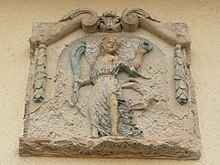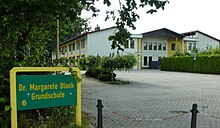Panitzsch
|
Panitzsch
community Borsdorf
Coordinates: 51 ° 21 ′ 48 ″ N , 12 ° 31 ′ 56 ″ E
|
||
|---|---|---|
| Height : | 123 m | |
| Residents : | 3273 (Dec. 31, 2013) | |
| Incorporation : | January 1, 1999 | |
| Postal code : | 04451 | |
| Area code : | 034291 | |
|
Location of Panitzsch in Saxony |
||
|
Panitzsch Church
|
||
Panitzsch is a district of the municipality of Borsdorf in the Leipzig district in Saxony .
geography
location
The place is in the Leipzig lowland bay between Borsdorf in the south and Taucha in the northeast. The A 14 runs about 3 kilometers west of Panitzsch and can be reached via the Leipzig East junction. The B 6 Leipzig – Wurzen (here originally: Via Regia ) runs about 1 kilometer south of the center in an east-west direction.
The Parthe flows through the village . The Parthewanderweg, from Zweenfurth via Borsdorf, Taucha and Leipzig-Plaußig to Leipzig-Schönefeld, also runs through Panitzsch.
Neighboring places
| Plösitz | Sehlis | |
| Serenity |

|
Cunnersdorf |
| Summer field | Borsdorf |
geology
The landscape around Panitzsch emerged around 130,000 years ago with the end of the Saale Cold Age . The gradual retreat of the ice formed terminal moraines , to which the Panitzscher Kirchberg can be counted. The meltwater from the receding ice masses originally flowed in an east-west direction along the edge of the ice.
At the beginning of the second Ice Age, today's Mulde also flowed in this direction. During the cold time of the Saale, this was sealed off by glacier deposits and has been flowing to Wurzen and Eilenburg since then . Mighty gravel deposits around Naunhof date from this time. The Parthe , which today mostly flows in the old Mulde area , was created in the former Mulde gravel.
In the north of the Panitzscher Flur there is boulder sand, while in the west there is essentially boulder clay with island-like mixtures of boulder sand. The boulder clay shows a weak layer of loess clay . The more recent soil formations, especially alluvial clay , can naturally be found along the Parthe run.
history
On February 14, 1267 Villa Bansc is mentioned for the first time in connection with the division of the former Friedeburg property , which was now awarded by Bishop Friedrich von Merseburg , who was present as an arbitrator, to Hoyer the Younger of Friedeburg . Villa ( Latin = country house or country estate) denotes the village and Bansc is possibly taken from the Polish (or other Slavic) language. Bana = valley or pit. Villa Bansc can therefore be interpreted as "village in the valley -" or "- in the pit of the Partheaue".
On April 29, 1269, he sold the Villa Bansc to Bishop Friedrich von Merseburg. Panitzsch is now in ecclesiastical possession, after it was previously under the administration of the Margrave of Landsberg .
The local border of the Mark Landsberg now formed the Parthe. Soon, however, in 1270, this sale led to numerous acts of violence in the diocese's possessions, which the Margrave Dietrich fanned. because they never came to an end, the Bishop of Merseburg imposed an interdict on November 10, 1270 on the territory of the margrave belonging to his diocese (church punishment, according to which all church official acts must be refrained from). In 1272 the disputes are said to have finally been settled.
Panitzsch was a settlement of economic importance. It was on the way to Leipzig, where merchants met for the fair, passed through here and occasionally stopped in the "Blue Angel". It is thanks to this fact that Panitzsch has not become a desert and has always been able to assert itself.
The inn, also known as the “Blauer Engel” tavern, was located in the middle of the village on Steinweg. That post and trade route, which at that time represented an important connection from the east via Bautzen - Großenhain to the trade fair and trade city of Leipzig and further to the west via Merseburg, with the “Blue Angel” being the last rest stop before Leipzig. Due to its large yard and spacious stables, it was not only frequented by carters, but also by strangers.
As old interest registers show, the hasty settlement policy had a negative effect towards the end of the 14th century through a sharp drop in the population and led to emigration of settlers, also from the immediate vicinity of Panitzsch. Devastation developed. In the west the village of Wilwisch, which was abandoned after 1349 (between Panitzsch and Sommerfeld , the Wilwischgraben still exists today ) and in the east around 1350 Cunradisdorf or Conratsdorf (today's Cunnersdorf), whose residents moved to Panitzsch.
August Schumann mentions Panitzsch in the State Lexicon of Saxony in 1821 concerning a. a .:
“Panitzsch has 70 houses with around 306 residents, a lot of strong estates with 36 hooves, a very small inn, a windmill in the west and a water mill in the east, a bridge over the river. The spiritual buildings u. s. w. The parish still understands the Althen and Sommerfeld branch (which is why the pastor has to preach 4 times on some festive days) and belongs to the Tauchaic circles of the Leipzig ephorias , the collatures are practiced by the Leipzig council. Many country butchers live in Panitzsch (70 in number) who are allowed to hawk in Leipzig on Tuesdays and Saturdays until 4 p.m., and mostly all of them on Saturdays, but usually only a small half on Tuesdays. You have to pay a fee for every head of cattle under the gate to the city council, and you have to accept the taration of the meat, which the chief masters of the Leipzig trade employ, whereby they are entitled to the tare by 1 Pf. Pr. To put pounds lower than for the town butchers; the butchers are also tied to a specific place in the city. "
It was only with the relocation of the main road and the construction of the state road Leipzig-Dresden via southern Borsdorf, as well as the opening of the first long-distance railway from Leipzig to Dresden in 1837, that Panitzsch lost its importance for transport. The place was until 1856 in the Electoral Saxon or Royal Saxon District Office Leipzig . From 1856 the place belonged to the Taucha court office and from 1875 to the Leipzig District Administration . In 1921 the eastern part of Cunnersdorf was incorporated. Since 1990, the population of Panitzsch has almost tripled due to the construction of new residential areas.
Panitzsch and Cunnersdorf have been part of Borsdorf since 1999.
Development of the population
|
|
|
Culture and sights
Attractions
- Baroque Panitzsch Church , originally Romanesque building from the 13th century
- Margarete Blank House
- Memorial stone for Margarete Blank
societies
|
|
education
The Dr. Margarete Blank Primary School is a two-class school with a school building from 1993 and a gymnasium from 1985, which was completely renovated in 2003.
Personalities
Sons and daughters of the place
- Maria Margaretha Kirch (1670–1720), astronomer
People related to the place
- Johann Jakob Vogel (1660–1729), theologian, pastor in Panitzsch
- Margarete Blank (1901–1945), doctor, lived and practiced from 1930 to 1945 in Panitzsch
Individual evidence
- ↑ a b c Chronicle 700 years Panitzsch 1267-1967 , accessed on August 17, 2017.
- ↑ cf. Panitzsch . In: August Schumann : Complete State, Post and Newspaper Lexicon of Saxony. 8th volume. Schumann, Zwickau 1821, p. 105.
- ^ Karlheinz Blaschke , Uwe Ulrich Jäschke : Kursächsischer Ämteratlas. Leipzig 2009, ISBN 978-3-937386-14-0 ; P. 60 f.
- ↑ The Amtshauptmannschaft Leipzig in the municipal register 1900
- ^ Area changes from January 1, 1999 to December 31, 1999. (PDF) State Statistical Office of the Free State of Saxony , p. 13 , accessed on February 15, 2016 .
- ↑ cf. Panitzsch in the Digital Historical Directory of Saxony
- ↑ Small-scale municipality sheet for Borsdorf. (PDF; 0.23 MB) State Statistical Office of the Free State of Saxony , September 2014, accessed on February 22, 2015 .
literature
- Panitzsch - On the 750th anniversary of the first mention . Editors: Jens Bulisch and Reinhard Freier. With contributions by Jens Bulisch, Reinhard Freier, Markus Cottin, Birgit Horn-Kolditz, Gerald Kolditz, Eberhard Fischer, Gerd Graupner, Gerhard Otto, Henning Schmidt. With a greeting from Regional Bishop Carsten Rentzing . Hard cover with numerous photographs, 388 pages, Leipzig 2017, ISBN 978-3-96008-938-4
- Chronicle 700 years Panitzsch 1267-1967, accessed on August 17, 2017
-
Heinz Quirin : Panitzsch. A home story. Originally published as a brochure (116 pages) without publisher information (printed by "Karl Lange, Leipzig O 5"), Panitzsch 1937.
- Republished in: Lutz Heydick, Uwe Schirmer, Markus Cottin (Eds.): On the history of churches and settlements in the Leipzig area (= Leipziger Land. Yearbook for Historical Regional Studies and Cultural Area Research , Vol. 2). Sax-Verlag, Beucha 2001, ISBN 3-934544-22-3 , pp. 181-234.
- Released in 2017 as a shortened reprint in connection with the publication of Panitzsch - On the 750th anniversary of the first mention (2017), A5 format, 101 pages, without ISBN.
- Cornelius Gurlitt : Panitzsch. In: Descriptive representation of the older architectural and art monuments of the Kingdom of Saxony. 16. Issue: Amtshauptmannschaft Leipzig (Leipzig Land) . CC Meinhold, Dresden 1894, p. 89.
- Panitzsch . In: August Schumann : Complete State, Post and Newspaper Lexicon of Saxony. 8th volume. Schumann, Zwickau 1821, p. 104 f.
Web links
- Cornelius Gurlitt : Panitzsch. In: Descriptive representation of the older architectural and art monuments of the Kingdom of Saxony. 16. Issue: Amtshauptmannschaft Leipzig (Leipzig Land) . CC Meinhold, Dresden 1894, p. 89.
- The history of Panitzsch with Cunnersdorf on www.borsdorf.eu
- Chronicle 700 years Panitzsch 1267-1967, accessed on August 17, 2017
- Dr. Margarete Blank memorial in Panitzsch
- ↑ Unfortunately, this reprint from 2017 withholds the abbreviations compared to the original from 1937: The overview of the frequency of changes in ownership of Panitz's goods (pages 85 and 86 in the reprint) lacks the following 14-page table overview in the original (in the original: pages 84–97) of the Panitzscher estates; therefore pages 85 and 86 in the reprint are de facto meaningless.








